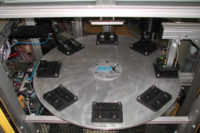Smart Materials Have a Bright Future

A good memory is something that money can’t buy. Memory will soon play a key role in the way that many types of products are designed and assembled in the future.
Engineers have been experimenting with shape-memory alloys and polymers that are referred to as “smart materials.” They change their shape, strength or stiffness when heat, stress, a magnetic field or electrical voltage is introduced.
Smart materials “remember” their original shape and can return to it, opening new possibilities for many movable features, such as replacing the electric motors traditionally used to activate car seats, windows and locks. There are numerous applications for the technology in the automotive, aerospace, appliance, medical and electronics industries.
John McElroy, host of the weekly Autoline Detroit TV show, claims that smart materials will change the look and feel of cars, because they will allow functionality to be designed into the parts themselves, enabling innovative designs and improved efficiency. “Actuators and sensors made from smart materials have the potential to improve vehicle performance and fuel economy, while also enabling new comfort and convenience features,” he points out.
McElroy believes these devices will eventually replace traditional motors and hydraulic devices. Smart materials will help reduce weight, component size and complexity, while improving design flexibility, functionality and reliability. In addition, they are impervious to water, moisture, dust and other elements that can wreak havoc on electric motors.
The most popular shape-memory alloy (SMA) is nickel-titanium, which is also known as Nitinol. Its unique properties were originally discovered 50 years ago by engineers at the U.S. Naval Ordnance Laboratory. Other SMAs include copper-aluminum-nickel, copper-zinc-aluminum and iron-manganese-silicon.
“Shape-memory alloys excel in applications where traditional actuation technologies are poor, such as small-scale and tight integration packages,” notes Geoff McKnight, manager of the active materials and adaptive structures technologies department at HRL Laboratories LLC, an R&D facility that’s owned by Boeing and General Motors. “As an actuator, they are most commonly used in wire form as electrically activated (resistance heating), high-force, small-displacement tensile motors.”
McKnight and his colleagues are currently pursuing the use of SMA technology in next-generation components and systems. “[Our] interests in SMAs span fundamental material mechanisms and behavior to manufacturing and integration issues,” he explains. “[We are] actively pursuing novel applications of SMAs, as well as their robust, temperature-independent control, sensing capabilities and life span.”
Engineers are interested in smart materials because they offer a way to reduce product complexity and reduce weight. “From an actuator technology perspective, SMAs provide many compelling advantages to traditional electromechanical or pneumatic actuation, including very compact size, silent operation, and low mass and cost,” claims McKnight. “These advantages allow a new class of smart components that provide interaction with users and enhanced features that were previously too expensive or complex to produce.
“In an alternative use-as highly elastic materials employing the pseudo-elastic effect-shape memory alloys can accommodate up to 20 times the strain of typical metals, making them useful for packaging and deployment operations, such as vascular stents,” adds McKnight.
Dynalloy Inc. is a 20-year-old company that markets a line of SMA wire called Flexinol that is used as actuators by a wide variety of manufacturers. Flexinol is made of nickel-titanium alloy. It comes wrapped on spools like traditional wire, with diameters ranging from 0.001 to 0.02 inch. Dynalloy claims that one 100-meter spool of Flexinol can replace approximately 1,000 electric motors. The wire contracts anywhere from 2 percent to 5 percent of its length, like muscles, when it is heated.
“Like a lightbulb, both heating and cooling can occur quite quickly,” explains Jeff Brown, program manager. “The contraction of Flexinol actuator wires when heated is opposite to ordinary thermal expansion, is larger by a hundredfold and exerts tremendous force for its small size. Movement occurs through an internal solid state restructuring in the material that is silent, smooth and powerful.
“In the correct applications, SMA can be less expensive, lighter, smaller and quieter (both electrically and acoustically) than traditional motor-solenoid, bimetal, piezo or paraffin actuators,” claims Brown. “The technology has been growing very fast. Our customers are currently working on some great projects that will be unveiled over the next five years.”

Numerous Applications
Many types of manufacturers can benefit from shape-memory alloys and polymers. Engineers have used Flexinol in products ranging from automotive seats to flying toys and cell phone antennas to sporting goods.
Siemens Corp. uses Flexinol in its dishwashers to release salt into water, which reduces spotting on glasses. Insulet Corp. uses shape-memory wires in its popular OmniPod insulin pump, which is used by diabetics. As a result, the lightweight, disposable product requires no bulky motor or solenoid.
The aerospace industry is also searching for new SMA applications. By using the material, engineers at Boeing, General Electric Co. and Goodrich Corp. developed a variable geometry chevron that reduces commercial aircraft engine noise. Chevrons are zigzag or sawtooth shapes at the back end of the nacelle and the engine exhaust nozzle, with tips that are bent slightly into the airflow. This creates vortices that form at each chevron, enhancing the mixing rate of the adjacent flow streams. When the chevrons enhance mixing by the right amount, jet engine noise diminishes.
Traditionally, automakers use hundreds of cable actuators, small electromagnetic motors and other mechanical devices to adjust mirrors, seats and headrests; operate windows and door locks; raise antennas; and release latches. Many of these components can be replaced with SMA.
Some of these applications involve replacement of existing motors, such as displays, locks and seating controls, as well as automation of previously passive devices, such as latches. Other innovative areas for SMAs in the auto industry include haptic interfaces, vehicle entry, automated HVAC components, and control of aerodynamics.
“Smart materials will change the look and feel of our cars and trucks,” claims Alan Taub, vice president of research, development and strategic planning at General Motors Co. “With these new materials, functionality can be programmed in to enable innovative designs, improved efficiency, and new and improved features that will make our vehicles more exciting to own and operate than the automobiles of the past.
“Actuators and sensors made from these materials have the potential to enable new comfort and convenience features,” adds Taub. “They can provide significant benefits when they are used to replace conventional motorized or hydraulic devices by reducing vehicle mass, component size and complexity, and improving design flexibility, functionality and reliability.
“The properties inherent in shape-memory alloys and polymers have the potential to be game-changers in the automotive advanced materials field, eventually leading to vehicle subsystems that can self-heal in the event of damage, or that can be designed to change color or appearance,” Taub points out.
General Motors engineers have been working on SMA applications since the mid-1990s. So far, 60 U.S. patents have been issued to the automaker and more than 100 other patents are pending. Jan Aase, director of GM’s vehicle development research lab, says the technology will likely first be used on 2013 model-year cars.
“We expect it to help us reduce the weight of our vehicles,” notes Aase. “Because of shape-memory alloys and polymers, we’ll achieve an 8 percent to 10 percent increase in fuel economy on cars equipped with conventional internal-combustion engines.”
According to Aase, potential GM applications include:
An adaptive interior grab handle that automatically presents itself from a folded position to make for an easier, more intuitive entry into a vehicle.
Active vehicle surfaces, such as air dams and louvers that adjust to govern airflow, improving aerodynamics and performance.
Hood, door latch and glove box releases that allow more convenient access.
Shape-memory alloys will also be used in the engine compartment. General Motors recently received a $2.7 million award from the U.S. Department of Energy to build a prototype system that will generate electricity from the waste heat found in automotive exhaust.
“When you heat up a stretched SMA wire, it shrinks back to its prestretched length, and when it cools back down it becomes less stiff and can revert to the original shape,” explains Aase. “A loop of this wire could be used to drive an electric generator to charge a battery.
“In a hybrid system, the electrical energy could be used to charge the battery,” Aase points out. “In a conventional engine, this could perhaps even replace the alternator without any load on the engine.”
Aase says the idea of an SMA heat engine has been around for 30 years, “but the few devices that have been built were too large and too inefficient to make it worthwhile.” Over the next two years, GM engineers will be working with the Smart Materials Collaborative Research Lab at the University of Michigan to create a working prototype.
Medical device engineers are also excited about the potential of smart materials, especially shape-memory polymers.
“These materials’ ability to mold actively to human bone and tissue will make them useful in several types of reconstructive surgery,” says Ken Gall, professor of materials science and engineering at the Georgia Institute of Technology. “You can insert the device in a shape or size ideal for placement, and then have it transform into a shape ideal for function.”
Gall and his colleagues have developed a shape-memory product that is ideal for orthopedic applications, such as knee replacements. Traditionally, doctors drill tunnels in bone and then anchor tendons into those tunnels with plastic or metal screw threads that often intrude into and injure tissue. However, the shape-memory polymer fits into a surgical tunnel along with the tendon, conforming around the delicate tendon to hold it in place.
“Most of the materials used in medicine are inactive, such as titanium, stainless steel, polyurethane and acrylic,” notes Gall. “They cannot respond to anything. By contrast, our materials are mechanically active-they respond to the human body by changing shape.”
In addition to knee surgery, Gall says shape-memory polymers may enable minimally invasive spinal surgery. Because the material is tough, it can stretch far and support a lot of weight like natural spinal disks. “This would improve the deliverability and life of artificial disks used in the spine,” claims Gall.
The Georgia Tech engineers have also designed a shape-memory polymer stent that can be compressed and fed through a tiny hole in the body into a blocked artery, just like a conventional metal stent. Body heat triggers the polymer’s expansion into its permanent shape, resulting in natural deployment without auxiliary medical devices. A
To learn more about smart materials, search www.assemblymag.com for these articles:
- Shape-Shifting Antennas.
- Smart Material Challenges.
Looking for a reprint of this article?
From high-res PDFs to custom plaques, order your copy today!





